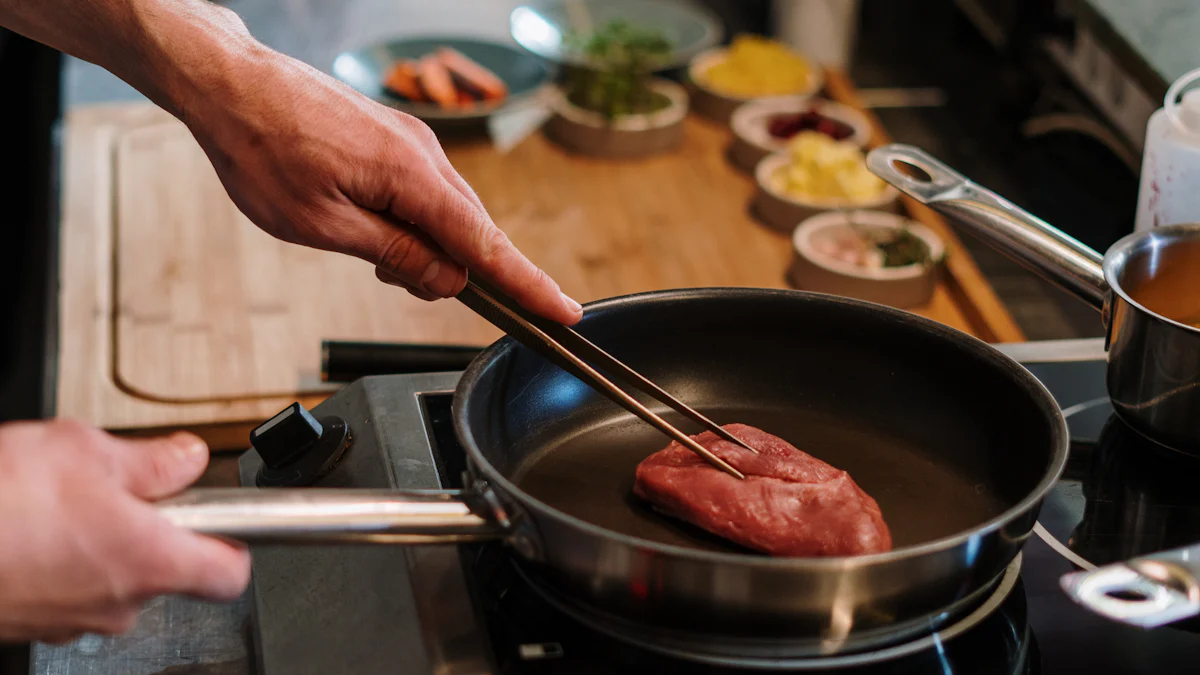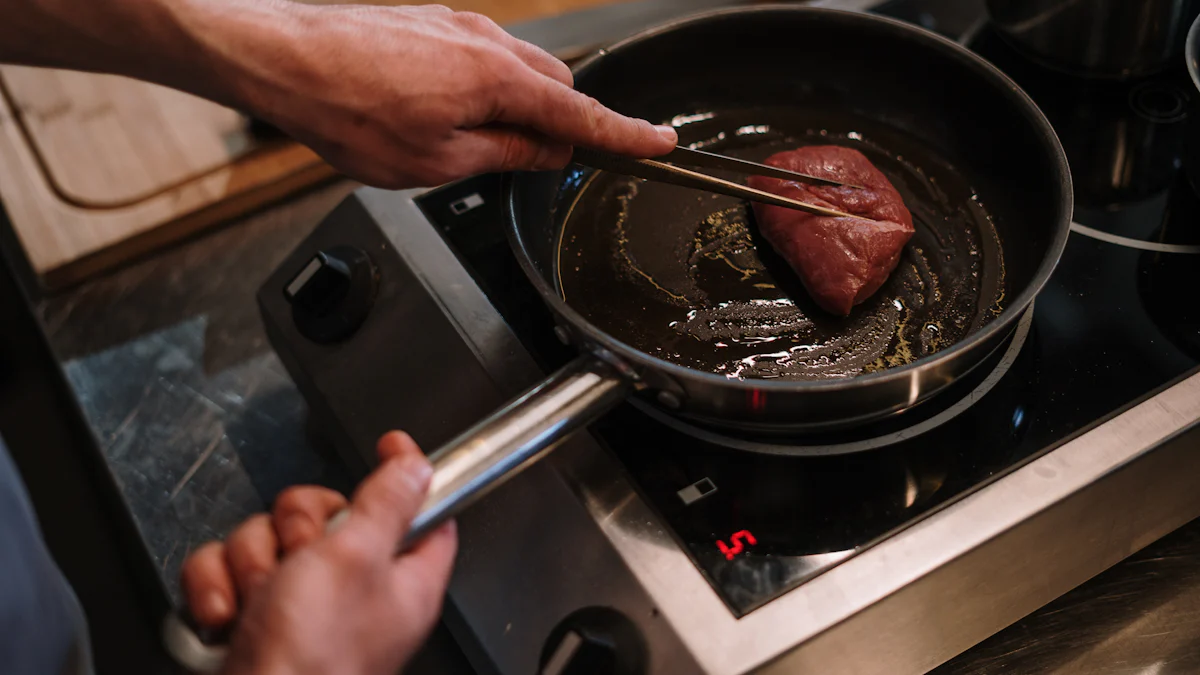Understanding Induction Cookers and Aluminum Pot Limitations

Induction cookers revolutionize your cooking experience by using magnetic fields to generate heat. However, aluminum pots pose a challenge. They lack the necessary ferromagnetic properties to interact with the magnetic field. This absence prevents them from heating effectively on induction cooktops. You might wonder why some aluminum cookware works. Manufacturers often add an induction bottom to these pots, allowing them to function on induction stoves. Understanding this science helps you choose the right cookware for your kitchen.
Key Takeaways
- Aluminum pots are generally incompatible with induction cooktops due to their lack of ferromagnetic properties, which are essential for generating heat.
- To use aluminum cookware on induction cooktops, look for pots with an induction bottom, which includes a magnetic layer that allows for effective heating.
- Testing your cookware for induction compatibility is simple: use a magnet. If it sticks, your cookware is suitable for induction cooking.
- Stainless steel and cast iron are the best materials for induction cooking, as they possess the necessary ferromagnetic properties for efficient heat transfer.
- Induction cooking is energy-efficient, reducing cooking times and energy consumption, which can lead to lower energy bills.
- Safety features of induction cooktops include a cool surface to prevent burns and automatic shut-off when cookware is removed, enhancing kitchen safety.
- Future advancements in induction technology promise new materials and broader compatibility, making it easier to find suitable cookware for induction cooking.
Why Aluminum Pots Are Not Compatible

Lack of Ferromagnetic Properties
Aluminum pots face a fundamental issue when it comes to induction cooking. They lack ferromagnetic properties, which are essential for generating heat on an induction cooktop.
Explanation of Ferromagnetism
Ferromagnetism refers to the ability of certain materials to form permanent magnets or be attracted to magnets. This property is crucial for induction cooking. Induction cookers create a magnetic field that interacts with ferromagnetic materials, producing heat. Without this interaction, the cookware remains cold.
Comparison with Compatible Materials
Materials like stainless steel and cast iron possess ferromagnetic properties. They contain iron, which responds to the magnetic field generated by induction cookers. This response allows them to heat up efficiently. In contrast, aluminum lacks these properties, making it incompatible without modifications.
The Role of Induction Bottoms in Aluminum Cookware
Manufacturers have developed solutions to make aluminum cookware usable on induction cooktops. They incorporate an induction bottom into the design.
How Induction Bottoms Work
An induction bottom typically consists of a magnetic layer added to the base of the aluminum pot. This layer interacts with the induction cooker’s magnetic field, allowing the pot to heat up. The induction bottom bridges the gap between non-ferromagnetic aluminum and the requirements of induction cooking.
Limitations of Induction Bottoms
While induction bottoms enable aluminum pots to work on induction cooktops, they come with limitations. The added layer can affect the pot’s weight and balance. Additionally, the efficiency of heat transfer may not match that of fully ferromagnetic cookware. You might notice uneven heating or longer cooking times compared to other materials.
How Induction Cookers Work

The Science of Induction Cooking
Induction cooking represents a modern approach to preparing meals. You might wonder how it works. The process relies on electromagnetic fields to generate heat directly in the cookware.
Electromagnetic Fields and Heat Generation
Induction cookers use electromagnetic fields to create heat. When you place a pot on the cooktop, the induction coil beneath the surface generates a magnetic field. This field induces an electric current in the cookware. The current then produces heat, cooking your food efficiently. Unlike traditional methods, the cooktop itself remains cool, as the heat is generated within the pot.
Role of Ferromagnetic Materials
Ferromagnetic materials play a crucial role in this process. These materials, such as iron, respond to the magnetic field by generating heat. You need cookware with ferromagnetic properties for induction cooking to work. Without these properties, the cookware will not heat up. This is why aluminum pots, without an induction bottom, fail to function on induction cooktops.
Advantages of Induction Cooking
Induction cooking offers several benefits that enhance your culinary experience. You gain efficiency and safety, making it a preferred choice for many.
Energy Efficiency
Induction cookers excel in energy efficiency. They transfer heat directly to the cookware, minimizing energy loss. You can cook meals faster and reduce energy consumption. This efficiency translates into cost savings on your energy bills.
Safety Features
Safety remains a top priority in induction cooking. The cooktop surface stays cool, reducing the risk of burns. You also benefit from automatic shut-off features. If you remove the pot, the cooker stops heating. This feature prevents accidents and ensures a safer cooking environment.
Choosing the Right Cookware for Induction
Selecting the right cookware for your induction cooktop ensures optimal performance and efficiency. You need to understand which materials work best and how to identify them.
Identifying Compatible Cookware
To ensure your cookware is suitable for induction cooking, you must verify its compatibility. This process involves a simple test and knowledge of recommended materials.
Testing for Magnetism
You can easily test cookware for induction compatibility by using a magnet. Place a magnet on the bottom of the pot or pan. If the magnet sticks firmly, the cookware is compatible with induction cooktops. This test confirms the presence of ferromagnetic materials necessary for induction cooking.
Recommended Materials
For induction cooking, certain materials perform exceptionally well. Stainless steel and cast iron are top choices due to their ferromagnetic properties. These materials interact effectively with the magnetic field generated by induction cookers, ensuring efficient heat transfer. While some aluminum cookware may feature an induction bottom, stainless steel and cast iron remain more reliable options.
Alternatives to Aluminum Cookware
If you find your aluminum pots unsuitable for induction cooking, consider alternatives that offer better performance and compatibility.
Stainless Steel
Stainless steel cookware stands out as a popular choice for induction cooking. It combines durability with excellent heat conduction. Many stainless steel pots and pans come with an induction bottom, enhancing their compatibility with induction cooktops. This feature ensures even heating and efficient cooking.
Cast Iron
Cast iron cookware offers another excellent alternative. Known for its superior heat retention, cast iron works seamlessly with induction cookers. Its heavy construction and ferromagnetic properties make it ideal for slow cooking and searing. Although heavier than other materials, cast iron provides consistent results on induction cooktops.
By choosing the right cookware, you enhance your induction cooking experience. Understanding the role of an induction bottom and selecting materials like stainless steel and cast iron ensures you achieve the best results in your kitchen.
Future Developments in Induction Technology
Innovations in Cookware Design
The future of induction technology promises exciting advancements in cookware design. You will see new materials and enhanced efficiency that will transform your cooking experience.
New Materials
Manufacturers are exploring innovative materials to improve induction cookware. These materials aim to enhance heat conduction and durability. You might encounter cookware made from advanced composites or alloys. These new materials will offer better performance and longevity. They will also provide more options for induction-compatible cookware.
Enhanced Efficiency
Efficiency remains a key focus in the evolution of induction technology. You can expect cookware designs that maximize energy transfer. These designs will reduce cooking times and energy consumption. Enhanced efficiency will make induction cooking even more appealing. You will enjoy faster meal preparation and lower energy bills.
Expanding Compatibility
Expanding compatibility is another area of development in induction technology. You will benefit from advances in induction base technology and a broader range of cookware options.
Advances in Induction Base Technology
Induction base technology continues to evolve. Manufacturers are developing bases that improve heat distribution and compatibility. You will find cookware with advanced induction bases that work seamlessly with various cooktops. These bases will ensure even heating and optimal performance.
Broader Range of Cookware Options
The future will bring a wider selection of induction-compatible cookware. You will have more choices beyond traditional materials like stainless steel and cast iron. Manufacturers are working on solutions to make more types of cookware suitable for induction cooking. This expansion will allow you to explore diverse cooking styles and techniques.
Our factory NINGBO XIANGHAI KITCHENWARE CO.,LTD. manufactures a wide range of cookware spare parts, such as induction disks, induction base plates, induction bottom plates, aluminum rivets, flat head rivets, handle flame guards, weld studs, handle brackets, pan brackets, steel hinges, screws, and washers, in order to provide our customers with the best quality products at the most competitive prices.
By staying informed about these developments, you can make the most of your induction cooking experience. Embrace the innovations in cookware design and expanded compatibility to enhance your culinary adventures.
You now understand why aluminum pots don’t suit induction cooking. They lack ferromagnetic properties, which are essential for generating heat on induction cooktops. Key points include the science behind induction technology and the importance of choosing compatible cookware like stainless steel and cast iron. Looking ahead, advancements in induction technology promise new materials and expanded compatibility. These innovations will enhance your cooking experience. Stay informed and embrace these changes to make the most of your culinary adventures.
FAQ
Why don’t aluminum pots work on induction cooktops?
Aluminum pots lack ferromagnetic properties. Induction cooktops require cookware with magnetic bases to generate heat. Aluminum doesn’t respond to the magnetic field, so it won’t heat up.
Can I use aluminum pots with an induction bottom on induction cooktops?
Yes, you can use aluminum pots with an induction bottom. Manufacturers add a magnetic layer to the base, allowing the pot to interact with the induction cooker’s magnetic field and heat up.
How can I test if my cookware is induction-compatible?
Use a magnet to test your cookware. Place it on the bottom of the pot or pan. If the magnet sticks firmly, your cookware is compatible with induction cooktops.
What materials are best for induction cooking?
Stainless steel and cast iron are excellent choices. They possess ferromagnetic properties, ensuring efficient heat transfer on induction cooktops.
Are there any safety benefits to using induction cooktops?
Induction cooktops offer significant safety benefits. The cooktop surface remains cool, reducing burn risks. They also feature automatic shut-off when you remove the pot, preventing accidents.
How does induction cooking save energy?
Induction cooking transfers heat directly to the cookware, minimizing energy loss. This efficiency reduces cooking times and lowers energy consumption, saving you money on energy bills.
What are the limitations of using induction bottoms on aluminum cookware?
Induction bottoms can affect the pot’s weight and balance. Heat transfer efficiency may not match fully ferromagnetic cookware, leading to uneven heating or longer cooking times.
Will future induction technology developments expand cookware compatibility?
Yes, future developments will likely expand compatibility. Advances in induction base technology and new materials will offer more options for induction-compatible cookware.
What innovations can we expect in induction cookware design?
Expect new materials and enhanced efficiency. Manufacturers are exploring advanced composites and alloys to improve heat conduction and durability, offering better performance and longevity.
Where can I find high-quality induction cookware parts?
The factory, NINGBO XIANGHAI KITCHENWARE CO., LTD., manufactures a wide range of cookware spare parts. It offer grill racks, induction disks, induction base plates, and more, ensuring top quality at competitive prices.
Post time: Dec-20-2024
